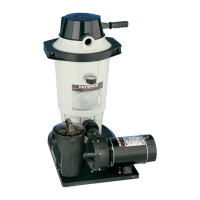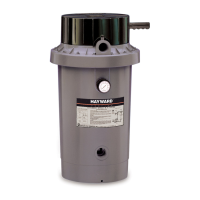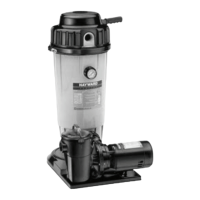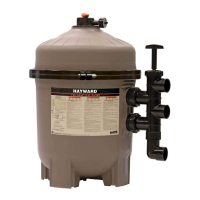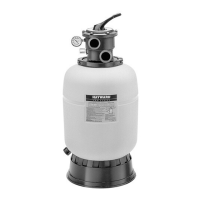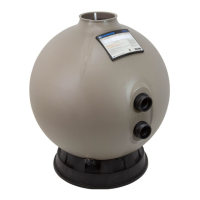USE ONLY HAYWARD GENUINE REPLACEMENT PARTS 7
SERVICE & REPAIRS
Consult your local authorized
Hayward-Perflex
dealer or service center. No returns may be made directly to the factory without the
expressed written authorization of Hayward Pool Products, Inc.
ALGAE CONTROL
Algae is a form of plant life which can vary in size from a few thousandths of an inch to the size of a small tree. Of the many forms of algae,
those most frequently found in swimming pool water are microscopic in size and green in color.
Algae readily grows in sunlight and can, under favorable conditions, quickly overgrow a swimming pool turning it completely green in just
a few hours. On the other hand, swimming pool water can be kept unfavorable to algae growth simply by maintaining a chlorine level of at
least 0.5 ppm in the water at all times. The chlorine level should be checked at least once a day using a suitable test kit.
If an algae condition develops and the pool water "blooms" green, superchlorination of the pool will be necessary to clear it. Add
unstabilized granular chlorine, or liquid chlorine.
Follow chemical manufacturer's recommendation for superchlorination. The algae will quickly become inactive and can then be removed
by the filter. Live algae, on the other hand, multiplies so fast that the filter cannot keep up with its growth rate. In an active algae
situation, it may be necessary to regenerate the Perflex filter as frequently as every 2 to 3 hours.
When correctly used, commercial algaecides are effective against algae, though algaecides should be used in conjunction with, and not
as a substitute for, regular chlorination or superchlorination.
Maintaining a chlorine level of at least 0.5 ppm in the pool water at all times is the most effective way to prevent algae growth in swimming
pools
SUGGESTED POOL CHEMISTRY LEVELS
ACTION REQUIRED TO CORRECT POOL CHEMISTR
TO RAISE TO LOWER
pH 7.2 to 7.6 Add Soda Ash Add Muriatic Acid or Sodium Bisulphate
TOTAL ALKALINIT
100 to 130 ppm Add Sodium Bicarbonate Add Muriatic Acid
CHLORINE (UNSTABILIZED) 0.3 to 1.0 ppm
Add Chlorine Chemical No action - chlorine will naturally dissipate
CHLORINE (STABILIZED) 1.0 to 3.0 ppm Add Chlorine Chemical No action - chlorine will naturally dissipate
CHLORINE STABILIZER 40 to 70 ppm
(Cyanuric Acid)
Add Stabilizer
Dilution - partially drain & refill pool with water
that has not been treated with Cyanuric Acid.
PROBLEM PROBABLE CAUSE REMED
Running at high
pressures.
1. D.E. coated with normal accumulation of pool dirt, algae, etc.
2. Overcharge of D.E.
3. Restriction in return line caused by small eyeball fitting.
4. Partially closed valve on return line.
1. Bump.
2. Bump-Drain-Recharge.
3. Change to larger size fitting.
4. Open valve.
Drop off of return
flow.
1. D.E. coated with normal accumulation of pool dirt, algae, etc.
2. Pump strainer basket clogged.
3. Skimmer basket clogged.
4. Pump impeller vanes clogged.
5. Air leak on suction side of pump.
6. Electric motor running less than maximum R.P.M. (under speed)
1. Bump. Clean.
2. Clean.
3. Cleaning with a stiff wire thru the pump strainer
opening will usually work. Alternate would be to
disassemble-and clean.
4. Check cover gasket, hand knobs, hose, clamps,
etc. Replace or tighten as necessary.
5. Consult pump and motor trouble shooting guide.
NOTE:
Most motor problems are due to:
a) Undersized or improper wiring.
b) Power cut-backs or a combination of both.
Short cycles.
1. D.E. loaded to capacity with pool dirt, algae, etc.
2. Bumping incorrectly.
3. Bump handle bent.
4. Pump output exceeds design flow rate of filter.
5. Presence of algae.
1. Bump-Drain-Recharge.
2. Slow down stroke - brisk upstroke. Repeat 6
times.
3. Check and straighten or replace.
4. Check GPM/LPM output. Regulate pump
GPM/LPM output to max. filter GPM/LPM rating.
5. Super-chlorinate; Bump-Drain-Recharge as
needed.
Short cycles --
even after proper
bumping,
draining, and
recharging
Contaminated (clogged) Fle
-Tube braids caused by:
a. Natural accumulation of chemical deposits (accelerated if
chemicals are fed thru skimmer).
b. Running D.E. charge too long with excessive amount of live
algae present in pool.
c. Operating filter without D.E.
d. Operating too long without D.E. after starting pump. D.E. must
be added as soon as filter is full of water and pump is putting out a
steady stream.
IMPORTANT —
Testing a new pool plumbing system without adding
D.E. will cause this type of clogging.
Clean Tube Nest
a) Detergent Cleaning: Remove tube nest and
hose down with forceful stream of clean
water. Soak tube nest in strong solution of
laundry detergent (such as
Cheer)
and warm
water. Hose down again.
b) Chemical Cleaning: This requires use of water
and muriatic acid solution (or filter cleaner-
type preparations) to chemically dissolve
contaminates. Consult your pool dealer for
chemical cleaning instructions.
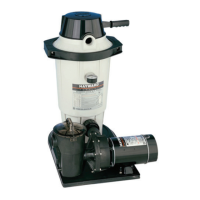
